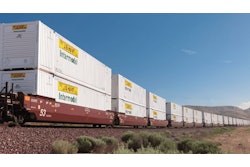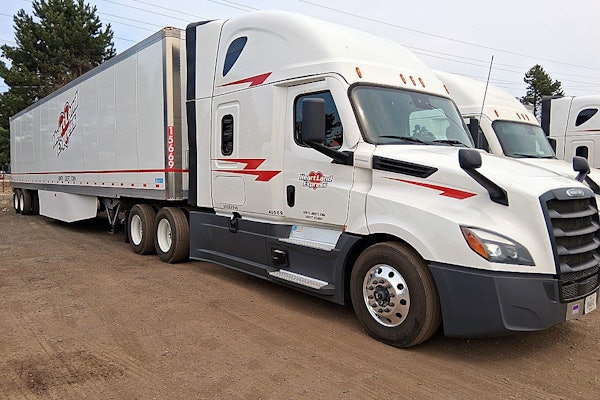Heat is a tire’s number one enemy and with ambient temperatures starting to climb, we’ll soon be in the 100s in parts of the U.S. That kind of heat will definitely impact tire inflation levels and tire life.
Contents of this video
00:00 10-44 intro
00:20 Heat and tires
00:40 How heat destroys tires
01:59 Sun exposure and sidewalls
03:18 Tire pressure management systems (TPMS)
05:50 PSI checkups
07:23 Signs a tire should be removed from service
08:19 When the tire is worn out
09:51 Valve stems and flow through caps
Speaker 1:
We're rounding first base into the summer driving season. Are your truck tires up for the heat you're watching? CCJs 10 44, a weekly episode that brings you the latest trucking industry news and updates from the editors of CCJ. Don't forget to subscribe and hit the bell for notification so you'll never miss an installment of 10 44. Hey everybody, welcome back to the 10 44. I'm Jason Cannon and my co-host is Matt Cole. Heat is a tire's number one worst enemy unless you don't mind blowouts and all the risk and all the expense that comes with it.
Speaker 2:
With ambient temperatures starting to climb right now, we'll soon be in the one hundreds and parts of the US and that kind of heat will definitely impact tire inflation levels and tire life
Speaker 3:
To start with, basically a tire is really a modern mar. It's put together with the steel and the rubber. Everything is molded together. There's no glues sticking the tire together. It's just basically getting the components to stick together and the ultimate enemy of a tire is heat, so the more deflection that you have, if you think of the steel cables in a tire like a paperclip and if you bend that paperclip back and forth enough, you weaken it and it will snap and that's where you get a zippering effect on the cords. But you also build up the heat internally in the tire and you get components basically to separate away from each other. That's where you get all the separations between the steel tread ply, the body cables and the different rubber compounds for that matter. So anything that causes more flexing than the tire is made to do is going to build up heat. Certainly the number one enemy of that flexing is air pressure. Any reduction in air pressure five, certainly even 10 PSI will absolutely cause that tire to overheat and start having components separate. At the very least, you'll degradate the casing and compromise its retread ability.
Speaker 1:
The sun beaten on the sidewall also causes ozone damage, which is something else to be on the lookout for.
Speaker 3:
Certainly in the sun in Florida and the south with the excessive sunlight and heat and everything, you're going to have ozone and cracking on the sidewalls. Basically the heat and everything causes ozone cracking. What you can do is rotate the tires. You could certainly turn them around, get 'em so that the outside tire on the commercial vehicle in a dual situation is the outside tire get flipped to the inside. There really isn't necessarily a product out there that's going to protect the sidewall of the tires. Some people have put some kind of a fry lube or Murphy soap on the sidewall of the tire. It's a little excessive. Typically that tire, it depends on how long the tires lasting too. If one season, probably not going to damage it. If you're wearing it out within a year, which a lot of trucks and commercial vehicles are pretty much getting over the road truck, it might get 150,000 miles on it where a local use regional tire might only get about 70, 80,000 miles on it, but that's typically around a year. If you get much more than a year of exposure on it, then you might want to turn that tire around before and move it to a different position where it's not going to get as much exposure on that one sidewall.
Speaker 2:
It doesn't take much of an ambient temperature swing to affect tire inflation levels. Making even more important a regular checkup, and we're not talking about tire thumping.
Speaker 3:
There are actually TPMS and inflation devices that allow for temperature differentials that compensate for that. If your tire overheats and when it's hot and you're taking the air pressure and say you're supposed to be running 105 PSI and a 14 ply tire, it may register 115, but because it's hot, you don't want to let the air pressure out because when it cools off you're going to be underinflated and as we said, under inflation's certainly more of an issue than overinflation and the heat expansion and everything will cause the tire to have some of the irregular wear, but it's less damaging to that tire overall than having it underinflated and the tire flexing too much. So yes, the ambient temperatures and the ambient heat are going to cause some problems and with that tire, the best thing that you can really do is in the back of everyone's product books is a loaded inflation tables and you try to keep based on your normal operating conditions, try to keep the air pressure adjusted to the load that you're carrying.
The 105 PSI on a 14 ply tire 120 on a 16 ply tire that is made for max load and just like on the side of your car, it's on the side of the inside the door panel on the car tells you to recommended air pressure. Don't go by what the max load air pressure is on the tire because that that's necessarily for the total load capacity of that tire not adjusting for the load. If you really want to balance it out and be exact, it's really best to go by those load and inflation charts and consult with your tire manufacturer to adjust that. Again, this is average one day you may be hauling very heavy and one day you might be hauling lighter. It's great. In an ideal world, they make automatic inflation systems that have TPMS and tire pressure monitoring systems are built in, and you would think in our high tech world that that might actually become a standard in the industry as critical as it is, but it's still a manual process for the most part.
Speaker 1:
A PSI checkup should be done at least daily, but ED says it's a best practice to monitor it in real time.
Speaker 3:
Ideally, a tire pressure monitoring system that you've mentioned before, that would be the ideal situation where in real time you're gauging that air pressure. Once that tire gets overheat it and for any real length of time and it heats up to its reversion point, which is the point where the rubber starts to lose its bond to the metal, to the steel cords and everything. Once it does that, the tire does not heal itself. So really the best concept is to have tire pressure monitoring systems on the trucks in the gauge at if you can do it, yes, it would be great ideally to have a pre-trip post-trip inspection process where you were sticking the air pressure, but that's a little excessive, at least if they can do it at least daily before you start it off. When it's cool, you want to try to gauge at cool temperature, so that's really with the ideal situation. So once you're post-trip inspections, usually the tires are going to be hot and it's not going to give you a good gauge of actual air pressure that you need to have in there, so pre-trip inspection air pressure would be ideal at least once a day. Unfortunately, many trucks, at least regional fleets, construction companies, they park that equipment once a week. They have our tire vendor come in and they will do a complete air pressure check, but again, by that point you may have already done the damage.
Speaker 2:
TPMS does a great job of monitoring pressure, but it's always going to fall in the driver and a good visual check to monitor the condition of the tire itself because A-T-P-M-S system can't see splits in the rover or bulges, which are telltale signs, a tire needs to be removed from service
Speaker 3:
You're looking at, the bulging is usually going to be your first sign. If you've gone to cracking in the sidewall, that tire's probably aging out. I'm going to suggest that it's going to take two to three years to get the cracking, that type of thing. Obviously, if you're checking the air pressure and noticing it on a regular basis at least once a week, you're probably going to start seeing whether the tire has some deflection. If it has been deflecting, you're going to start getting bubbles. Typically, those bubbles start out in the sidewall on the upper shoulder or you're going to get some kind of a cracking near the bead. Those are the two areas that you're going to have the most vulnerable.
Speaker 1:
Now, once you see those, the tire's done, there's no bringing it back, and time is not on your side.
Speaker 3:
The damage has been done. It really needs to be removed from service pretty promptly and no retreading or repair process is going to help it. Once it separates or starts to crack like that, typically you won't see it in the tread area as much. It is going to be in that shoulder, upper shoulder area where it is deflecting the most. Are you familiar with the zipper concept? So the same thing with the back to the paperclip concept where it's flexing. Most of that flexing going to be in that upper shoulder and that's where you won't even see it. The steel belts inside are already starting to wear. Once a few of those steel belts let loose, the rest of the air pressure is going to push and there just won't be enough strength. Think of a steel, like a suspension bridge and you cut a few of those cables, the whole thing's going to collapse and it zippers open, and that's typically more of the case. Modern tires, you don't see as much separation in the steel belted tires as you used to see in the bias or in construction tires where there's still some nylon and heavier, more rubber on the sidewalls. Unfortunately, you're probably not going to see much until it starts. A zipper effect is what's going to happen, and that's we're monitoring that tire pressure constantly and knowing it before it's going to happen.
Speaker 2:
While you're checking out the tire. Ed suggests looking over an often overlooked part of the tire, but one that's absolutely critical in putting air in and keeping it in.
Speaker 3:
One of your biggest places that you're going to lose air is in the valve stem, and it's always good if you're going to be checking the air on a regular basis, is to use a flow through cap. That valve core in there is meant to allow air to get into the tire. Yes, it seals, but it's more to let air in. A valve cap is really essential and it flow through valve cap, still seals that valve stem off, but allows you to easily access the air pressure to put air pressure in very cheap. You can go out and buy a bunch of 'em, probably for a buck or so, maybe $2 a piece at this point, and they're fairly inexpensive and it'll save you a lot of time trying to screw valve cap on and off, but that valve cap is critical to keeping the air pressure in that tire. That's probably your biggest source of air loss. Air will infiltrate the casing and come through, but that's very slow. The other places through the bead and the wheel, as the wheel fluctuates, temperatures fluctuate more than the rubber fluctuates, so you can get air loss there, but probably the number one place that you're going to lose air pressure is the valve stem and that valve core.
Speaker 1:
That's it for this week's 10 44. You can read more on ccj digital.com. While you're there, sign up for our newsletter and stay up to date on the latest in trucking industry news and trends. If you have any questions or feedback, please let us know in the comments below. Don't forget to subscribe and hit the bell for notifications so you can catch us again next week.










